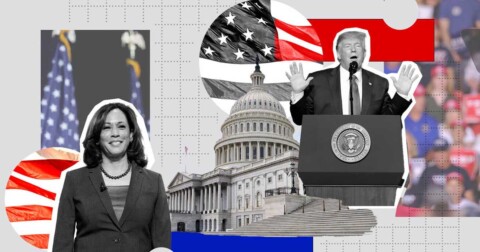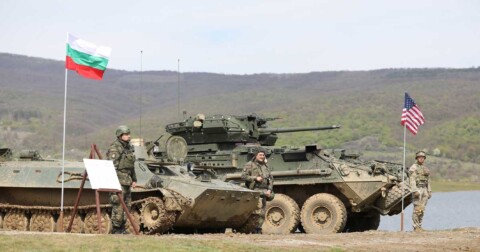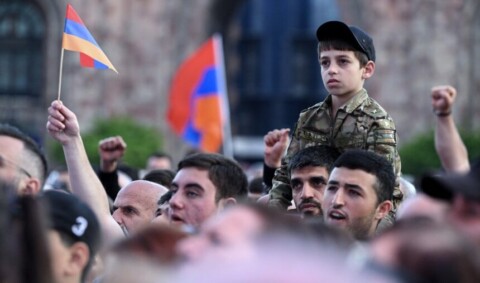A lightning offensive by the rebels has ended the Assad family’s 50-year rule. The news was celebrated on the streets of Damascus but also caused concern for many. Since the beginning of the civil war, Syria has been divided along ethnic and religious lines. In the central regions of Syria, where Sunnis dominate, extremists from the group Hayat Tahrir al-Sham (HTS) have taken control. The northwestern parts of the country are controlled by the Turkish-backed Syrian National Army (SNA), while the northeastern areas are under the control of the Kurds through their organization, the Syrian Democratic Forces (SDF). The rest of the country – the western regions stretching from Damascus to Idlib – was under Assad’s forces until the moment a ceasefire was declared between Israel and Hezbollah.
DRUZE – A BUFFER ZONE IN INTERACTION WITH ISRAEL
The US and the EU paradoxically attempted to prevent the conflict from spreading to the rest of the Middle East and to allow Israel to consolidate its military capabilities. At the moment the ceasefire was signed, HTS forces launched a comprehensive offensive and within just 11 days managed to break the resistance of Assad’s forces. HTS units took control of the western parts of the country, including the port cities of Latakia and Tartus. Within HTS itself, there are internal factional divisions. In the south, two groups operate – the Syrian Free Army (SFA) and the so-called Southern Operations Room, which are conditionally allied with HTS. The SFA, supported by the US, managed to expand from the Al-Tanf military base, located on the Jordanian border, all the way to Palmyra and parts of Damascus. The other half of Damascus is controlled by the Southern Operations Room, which, from the perspective of Islamic fundamentalism, represents an “unprincipled” coalition between Sunnis and Druze. Since their operational domain borders Israel, it became necessary to involve local Druze, who would form a kind of buffer zone in interaction with Israel. However, the question arises – how did Syria find itself in this situation? Why did Assad’s regime collapse in just 11 days, despite managing to stay in power for nearly 13 years through a civil war? There are numerous theories about the sudden collapse of the regime in Damascus. Syria is an ethnically, religiously, and politically highly heterogeneous country, and the factions that have “feudalized” Syria (some estimates suggest around 38 factions currently operate within Syria) could further fragment and enter into conflicts with one another.
ARAB AFFAIRS
What is indisputable is that the regime had been subjected to harsh sanctions for years, targeted by Israeli airstrikes and bombings. However, despite the actions of Russian and Syrian air forces, the Syrian army’s ground troops were unwilling to offer even minimal resistance. It is suspected that Western, Turkish, and Israeli intelligence services bribed Syrian generals and high-ranking officials, contributing to the rapid disintegration of the military. This assumption is based on the fact that, due to sanctions and poverty, the average salary of a Syrian general amounted to just $40 per month, while, for example, HTS fighters received $2,000. On the other hand, some believe that Syrians and other Arab nations lack political and state-building awareness. Although Arabs have a long history and tradition, Arab states as such are modern, post-colonial phenomena, and their institutions suffer from a lack of historical foundation. There is also the issue of identification and equating the regime, i.e., the leader, with the state itself. When reflecting on this problem, it is worth mentioning an article written by the late Miroslav Lazanski on the eve of Gaddafi’s fall in Libya. Gaddafi’s supporters were cornered in the city of Sirte, and even those who had backed the colonel in the city ceased to do so within a matter of days. This would not be particularly noteworthy if the majority of the opposition’s paramilitary formations had not been made up of his former most fervent supporters. “The same people who cheered for Gaddafi in Tripoli’s Green Square were now delivering his death sentence at the same place.” As Lazanski concludes – “Arab affairs.”

EFFECTS OF THE SYRIAN CRISIS
When a country like Syria, located at an important geographical, transport, and strategic crossroads, finds itself in such a situation, any form of instability will inevitably produce consequences that affect the interests of regional players. The effects of the Syrian crisis could influence the position and role of various interested parties in the Middle East in multiple ways. Therefore, it is essential to thoroughly analyze the stance of each power under the new geopolitical circumstances. For over a decade, Iran has been a decisive factor in the Syrian civil war. Through various means, it attempted to keep Assad in power with the goal of establishing a land corridor to directly link with its proxy in Lebanon. Without this so-called “Shia Crescent” corridor — somewhat comparable in geopolitical significance to the Suwałki Corridor — Iran would not be able to support Hezbollah or project the power it currently holds. However, the significance of the corridor extends far beyond that. It serves as a counterbalance to Sunni powers such as the UAE, Saudi Arabia, Qatar, and Turkey, stretching from the Persian Gulf to the Mediterranean Sea, thereby preventing their unification and connectivity.
IRAN’S GEOPOLITICAL CALCULATIONS
To deter Israel, Syria could serve Iran as a kind of frontier state – part of a potential Iranian version of an A2/AD (Anti-Access/Area Denial) missile shield. In other words, Iran cannot be a regional power without Syria. However, the events of October 7 and the outbreak of war in Gaza represent a significant turning point. While Israel bombed Hezbollah positions and the Houthis were under continuous attack by the US and the UK due to the blockade of the Bab al-Mandab Strait, Iran was forced to divert its resources to support its proxies. As a result, it could no longer focus on Syria and the Assad regime as it had before. There is another reason why Syria is a key part of Iran’s geopolitical strategy. Iran views the construction of the Iran-Syria oil pipeline, which would traverse Iraq and Syria to reach Europe, as strategically essential. Syria occupies an important place in these plans as a transit country. The pipeline’s function is primarily geopolitical – it aligns with Iran’s “Shia Crescent” strategy, blocks energy expansion by Gulf states, and curtails Turkey’s ambitions to position itself as a hub for pipelines from Gulf monarchies. However, the current situation in Syria complicates Iran’s pipeline construction plans.
THE DYNAMICS OF ERDOĞAN AND ASSAD’S RELATIONSHIP
To understand the current Syrian crisis, it is necessary to analyze Turkey’s behavior. Turkish foreign policy is characterized by four primary vectors derived from its historical experiences, which Turkey applies depending on the situation and its current power. The first vector can be described as Pan-Turanism, where Turkey seeks to position itself as the “center of Turanism” by emphasizing its pre-Islamic, ethnically Turkic identity. This vector targets other Turkic peoples, particularly in areas from the Caucasus and Central Asia to central Siberia and China’s western borders. The second vector is Atlanticism or Europhilia, drawing historical legitimacy from Atatürk’s legacy. Through NATO membership and potential EU accession, Turkey aims to extend its influence in the Balkans and counter Greece as its primary regional rival. The third vector is Pan-Islamism, based on the historical fact that Ottoman sultans held the title of Caliph from the 16th to the 20th century. Turkey seeks to position itself as a leading power in the Sunni world. In this context, the evolving dynamics between Erdoğan and Assad are particularly interesting – ranging from joint vacations to Erdoğan playing a significant role in the downfall of Assad’s regime.
PAN-ISLAMISM AS A COUNTERWEIGHT TO THE “SHIA CRESCENT”
While Erdoğan and Assad maintained good relations, they planned to establish a so-called “Middle Eastern Schengen Zone,” which perfectly aligned with Turkey’s pan-Islamist ambitions. Pan-Islamism also plays a crucial role as a counterbalance to the “Shia Crescent,” as Turkey perceives itself as the only power capable of uniting all Sunni states to sever the “Crescent” and weaken Iran’s influence in the region. In recent years, Assad sought to break free from Iran’s embrace by improving relations with the UAE and Saudi Arabia, culminating in Syria’s readmission to the Arab League in August 2023. The fourth and final vector is Neo-Ottomanism, which, according to Orientalist Dr. Darko Tanasković, represents the most significant and frequently employed aspect of Erdoğan’s foreign policy. It aligns perfectly with the earlier pan-Islamist vector. A telling anecdote illustrates this: when HTS forces seized Aleppo, Erdoğan’s daughter posted a photo on social media of the Turkish flag flying over the city, commenting that the time for Ottoman revival had come and that Aleppo had once again become an Ottoman city.
THE KEY TO UNDERSTANDING – THE QATAR-TURKEY PIPELINE
In Turkey’s broader geopolitical calculus, the Kurdish factor remains paramount — arguably the greatest challenge facing modern Turkey. The Kurdish stronghold in northeastern Syria represents a persistent threat. Turkey will never permit the formation of a Kurdish state, or even a quasi-state entity, as such a development would destabilize Kurdish-populated regions, including Turkey itself. One of the alleged causes of the Syrian civil war was Assad’s refusal in 2009 to join the Qatar-Turkey pipeline project. This pipeline would have stretched from Qatar, through Saudi Arabia, Jordan, and Syria, to Turkey, and further into Europe. The goal of the pipeline was to diversify gas supply routes and reduce Europe’s dependence on Russian and Iranian energy resources. Through this project, Gulf states aimed to consolidate the influence of the Gulf Cooperation Council (GCC) on global energy markets. Additionally, Turkey sought to leverage the pipeline to strengthen its international standing. The developments in Syria gave further momentum to pipeline plans, effectively jeopardizing Iran’s ambitions to construct its own oil pipeline.

SCORCHED EARTH TACTIC
Israel’s geopolitical doctrine and actions concerning the Syrian crisis largely align with Turkish plans. However, it is often overlooked that Israel may not necessarily favor Assad’s removal. Although Netanyahu welcomed the fall of Assad’s regime, it is important to note that the regime change has created a “strategic vacuum” that could potentially be filled by jihadists from HTS. From Israel’s perspective, Assad’s Syria is a threat, but Sunni extremists pose an even greater danger. To prevent the military establishment of a new jihadist government, Israel employs a “scorched earth” tactic, continuously bombing military bases and airfields across Syria. Meanwhile, Israeli ground forces launched an offensive from the Golan Heights, capturing the summit of Mount Hermon and currently standing 27 km from Damascus. Additionally, the Israeli Air Force has eliminated the remnants of the Syrian navy. Israel may use the chaos in Syria to confront Hezbollah and Hamas, as the delivery of Iranian logistical support has been halted indefinitely.
ISRAEL’S DIAGONAL CORRIDOR
In the midst of Syria’s factional landscape, Israel’s only potential ally is the Kurdish Syrian Democratic Forces (SDF), backed by the US. With US assistance, Israel could establish a diagonal corridor stretching from the Golan Heights along Syria’s eastern border to SDF-controlled areas. From a geopolitical perspective, this corridor would perfectly align with Turkey’s pan-Islamic and neo-Ottoman foreign policy vectors. Iran’s “Shia Crescent” would come under synchronized attack from Israel and Turkey. Although this may seem unusual, especially given Erdoğan’s rhetoric against Israel and Netanyahu regarding the Gaza war, there is creeping cooperation between Turkey and Israel. Despite strained trade relations, oil continues to flow to Israel via Turkey. Another significant factor in Ankara-Tel Aviv relations is the long-term plan to connect Israel’s “diagonal” with Turkey’s sphere of influence in northern Syria, facilitating the realization of the Qatar-Turkey pipeline project.
2015 – A TURNING POINT IN THE POST-COLD WAR ERA
Unlike the previously mentioned states, which can be classified as regional powers, Russia is a global power, making its geopolitical approach to Syria more complex. When Russian forces launched their military operation in Syria in 2015, it marked a pivotal moment in the post-Cold War era. Following the collapse of the USSR, Moscow worked to regain its lost status and influence on the international stage. Syria became a symbol of that process; it was Russia’s first military intervention outside the post-Soviet sphere. Although Russia had previously conducted military operations, they were confined to the Soviet domain, leading Washington to perceive Russia as a regional power. By altering the course of the civil war, Moscow demonstrated its ability to influence major global crises. The recent fall of Assad’s regime, which survived solely due to Russian intervention, represents another turning point. Russia’s involvement in the Middle East enhanced its reputation in the region. Key powers — Saudi Arabia, Turkey, Iran, and even Israel — began recognizing Russia as a major player in the balance of power. The formation of OPEC+ was made possible by Riyadh’s desire to strengthen ties with Moscow. At the moment Russia reached its post-Soviet peak, the international landscape shifted.
MOSCOW LOSES ITS STRATEGIC ADVANTAGE
The post-Cold War period, during which great power status was fluid and flexible, has unraveled into a world of shifting and unstable alliances. Today’s international order resembles the conditions following the Peace of Westphalia in 1648, where the concept of national states and interests was elevated above broader alliances and coalition partnerships. Russia’s reduced activity in Syria exemplifies this shift. Due to the war in Ukraine, Moscow has lost its previous strategic advantage, as securing long-term gains through military success has become nearly impossible. The ability to swiftly adapt to new circumstances was a lesson the US learned the hard way by withdrawing from Afghanistan in 2021. Now, Russia faces a similar challenge. In the meantime, Russian forces are hastily retreating from the Kobani base. Russian strategists are anxious about the fate of the Khmeimim airbase and the Tartus naval facility. With limited resources, the current situation is forcing Russia to redefine its geopolitical approach to the Middle East. Russia’s presence in Syria was largely driven by the goal of preventing the construction of the Qatar-Turkey gas pipeline. The pipeline’s construction is not just in the interest of regional Middle Eastern powers — the US and the EU also supported the project to reduce Europe’s dependence on Russian gas. Alexander Dugin once stated that energy is Russia’s most powerful geopolitical weapon, emphasizing the need for Moscow to maintain its monopoly on supplying gas and other energy resources to Europe. Russia’s opposition to the Qatar-Turkey pipeline fostered closer ties with Iran, leading to coordinated actions in Syria and broader Middle Eastern cooperation.

DON’T RUSH TO CONCLUSIONS
From everything outlined, it may seem that Turkey is the biggest winner from the regime change in Syria, while Iran is the greatest loser. However, a deeper analysis reveals that this may not necessarily be the case. Although Iran’s position as a regional power has been called into question, this could be a temporary rather than a permanent setback. As previously mentioned, Syria is currently undergoing a process of “feudalization.” Around 38 factions operate within Syria, each with different ideological, religious, and geopolitical agendas. Iran could attempt to align with some of these factions to revive the Syrian segment of the “Shia Crescent” through an axis made up of local “Hezbollah-like” groups. To win their loyalty, Iran might leverage anti-Israel and pro-Palestinian sentiments, positioning itself as their primary supplier of arms, ammunition, and other necessities. Most analysts believe that Turkey has profited the most from Assad’s fall. However, certain details warrant closer attention. Assad’s removal has opened Pandora’s box concerning security in the Middle East.
THE UNPREDICTABILITY OF EXTREMISTS
Turkey, by all accounts, backs the HTS (Hayat Tahrir al-Sham) organization and its leader, Abu Mohammad al-Jolani. HTS consists of rebranded Al-Qaeda fighters, initially formed and armed by the US and Turkey in 2017. However, history shows that Islamic extremists are unpredictable and often turn against their sponsors over time. As a result, an increase in terrorist attacks can be expected across the region — from Turkey to Central Asia. By creating a “powder keg” on its doorstep, Turkey may have made a strategic miscalculation, given its ongoing struggles with terrorism and Kurdish separatism. The Kurdish issue has long strained US-Turkish relations. The Kurds remain America’s primary partner in the region, and US Senator Lindsey Graham recently stated that the US will not allow Turkey to eliminate the SDF (Syrian Democratic Forces) and will impose sanctions if Turkey attempts to do so. Pan-Islamic or neo-Ottoman foreign policy vectors should be interpreted solely in the context of relations with other Muslim states. Apart from Qatar — and primarily for economic reasons — Turkey is viewed with suspicion across both the Arab and broader Islamic world. Turkey’s ambitions far exceed its capabilities, leading to conflicts with other potential Sunni hegemons such as Egypt, Saudi Arabia, the UAE, and even Indonesia on a larger scale.
ISRAELI ROULETTE
Like Turkey, Israel faces similar challenges. Assad’s Syria posed a threat primarily because Iran used it to supply Hezbollah and Hamas with weapons, ammunition, and military equipment. However, Assad’s departure has introduced a new danger. Although HTS (Hayat Tahrir al-Sham) is a product of US intelligence services, the unpredictability of its leaders remains a major concern for both Turkey and Israel. This is why the Israeli Air Force is currently conducting active operations, aiming to capitalize on the “interregnum” period to further disable the military capabilities of potential enemies. The risk would escalate significantly if Iran established ties with some of the factions and steered them toward an anti-Israel agenda. Looking at the plan to create a diagonal corridor, several shortcomings emerge. The corridor would stretch along Syria’s eastern border, but these areas are sparsely populated, creating significant logistical challenges for maintaining it. Additionally, the US is unlikely to allow excessive cooperation between Israel and the SDF (Syrian Democratic Forces), as this could jeopardize relations with Turkey. The US continues to balance between Turkey and the Kurds, ensuring that neither side achieves overwhelming military or strategic dominance. Consequently, Israel cannot expect to strengthen its positions through deeper engagement with the SDF.
THE FATE OF RUSSIAN BASES
It remains uncertain whether Russia will withdraw from its bases in Syria. The issue is still under discussion, although Russian authorities have established contact with both HTS and Syrian opposition factions backed by Turkey. It is possible that Russia will recognize the new government, provided that its military presence is not challenged. Should Russia withdraw, it may seek a new foothold in Libya, likely in territories controlled by Field Marshal Khalifa Haftar. One of Russia’s long-standing geopolitical objectives, dating back to Peter the Great, has been to secure access to warm waters, making it difficult to imagine that Russia would abandon the Mediterranean so easily. Regarding energy geopolitics, the Qatar-Turkey pipeline no longer poses the same threat to Russia as it once did. Since the start of the war in Ukraine, the EU has largely shifted away from Russian gas and turned to importing liquefied natural gas (LNG), primarily from the US, but also from Russia, as LNG is not subject to sanctions.
SABOTAGING THE PIPELINE CONSTRUCTION
Even if the Qatar-Turkey pipeline were built, it would not significantly impact Russia’s economy. Moscow is actively developing new pipelines to China, India, and Iran. However, the key question remains whether construction will ever begin, given Syria’s chaotic state as the main transit country. Like Iran, Russia could exploit Syria’s factional divisions to sabotage the pipeline’s construction. At present, Russia’s highest priority is the war along its own borders, directing all available resources to that front. While withdrawing from Syria would dent Russia’s international credibility, it is important to recognize that Moscow no longer has the capacity for extensive geopolitical reach. Additionally, the instability in Syria would require greater investments to secure military personnel and infrastructure. Syria has become a “hot potato,” and Russia is unwilling to hold onto it alone.





